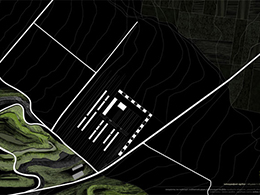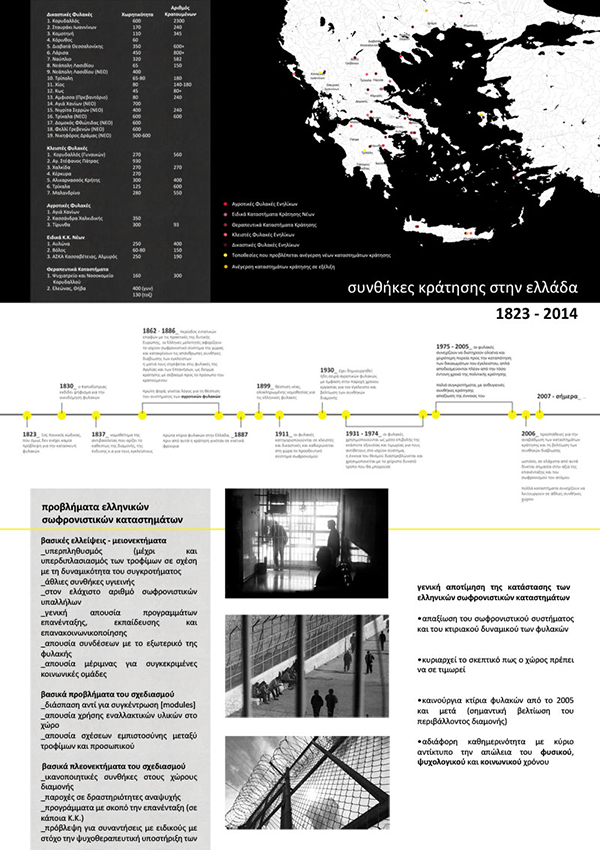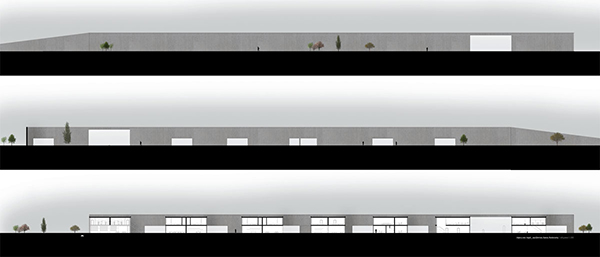STUDENTS PROJECTS
PROJECTS2013

05 June, 2015
Alternative correctional facility in Volos
The subject of this diploma project is to redefine the idea of confinement as a correctional means in a prison facility.
Students: Adamantia Karavasili, Alkistis Mavroeidi
Supervisors: Ariadne Vozani, Costas Caradimas
School of Architectural Engineering, National Technical University of Athens
Submission Date: July 31, 2014
The subject of this diploma project is to redefine the idea of confinement as a correctional means in a prison facility. Our goal the integration of correctional facilities to the community, instead of their exclusion, through an approach that will create an experimental base for the development of more humane conditions of doing a sentence in the Greek community.

The correctional facilities are a part of modern day society that demands our attention. The reason is that they are still treated as an extrinsic element in communities, both from a social and an architectural point of view. As a result, the study of this subject is based on the belief that by reconsidering and restructuring the form and the function of the correctional facilities, one can contribute to them becoming living elements in a society, and through them to better achieve correction and reintegration of inmates.
"One cannot educate a man about freedom in confinement conditions"
Sir Alexander Peterson
Essentially, the major theme that we are trying to redefine is confinement. Confinement, meaning the deprivation of freedom as a means of punishment and justice, is met in societies throughout the ages. However, in many cases it is a very cruel measure and mostly ineffective when it comes to correction, especially when it is not applied in combination with the appropriate correctional and reintegration processes. Understanding the inmate's psychology is important since he is still an active member of this society that needs to realize why his delinquent behavior is wrong and how to reintegrate into society as a whole. This is why this subject needs to be handled with both architectural and social sensitivity.
Therefore, we moved on two basic axes when dealing with the design and functional issues of the subject; Time and boundary.
Time
One of the most important aspects of an inmate's life is the evaluation of the use of their time during their sentence. According to psychologists, a prisoner's time is defined as physical, social and psychological time. In today's prison systems, psychological time (the time in which the inmate sees himself, after his release, reintegrated into society) is diminished to almost zero and the inmates find it impossible to picture themselves as active members of society again. Activities that will give them the feeling and the possibility of integration are not playing an important role currently, and thus are not enough to rebuild their psychological confidence. Therefore, the program that we want to implement in this alternative correctional facility aspires to both reduce the reoffending percentage of released inmates, and facilitate the actual reintegration into the society through professional specialization as well as the development of the feeling of being and active and useful member of society after their release. These programs are based on agricultural activities and production, as well as on specialization and craftsmanship and a second-chance education school system.
Boundary
The most important characteristic of a prison is its boundary. Modern day prisons look like fortresses, with 3 layer of walls up to 6 meters high and spiked wired fences in their perimeter, making the inmates feel completely secluded from the outside environment. This immediately defines them as dangerous for the community, which often does not reflect a true image. In our proposal, the boundary is non-existent, as a sign of trust towards the inmates and towards the function of the program within the correctional facility, based on the concept that inmates do not feel the need to escape when their presence there is not a means of torture or humiliation, but a process of redefining their values and preparing to return to society. What greatly contributes to this is the positive impact of work and occupation of the inmates through the programs, as well as the development of relationships of trust, cooperation and mutual respect with the intrinsic community.
The location and the inmates
The alternative correctional center is located near the city of Volos, in a land outside the village of Aidini, where the correctional facility of ASKA Kassaveteia is also located. The location and the climate favor the function of the facility as an open agricultural correctional center and allow all the agricultural activities that we have studied, as well as the possible cooperation with surrounding agricultural facilities and the ASKA center.
The inmate demographics have been chosen to refer to women, minors and adults, and possibly mothers with young children, an inmate population that has been neglected since there are currently not enough or satisfactory facilities within the prison building of Greece for their stay. The women who have been sentenced for crimes of non-violent nature, as well as women who have already completed part of their sentence in other facilities and have displayed good conformance have the right to stay here.
Design approach
Our main tool for designing the facility has been the use of walls. The wall's essence is transform from a means of separation as it is traditionally used in prisons, to a means of defining spaces, entrances, building complexes and social meeting points. The space is organized around the idea of gradual levels of privacy for the inmates and their activity groups. The living complexes are bordering the agricultural spaces, thus assigning them full responsibility over the crops and to have them easily accessible from their personal space. The living units offer different rooms according to the inmate's needs and common spaces for social activities and community cooperation. The square in the center of the synthesis represents the opening of the prison to the outside world and the possibility of having people entering and engaging into activities within the facility, as well as the possibility of all the inmates collectively gathering in the central courtyard in order to encourage collective activities, entertainment and communication.














Related articles:
- Penitentiary architecture ( 23 February, 2011 )
- A different physical layout of prison facilities ( 29 September, 2012 )
- PRISON-OFF. Juvenile Detention Center ( 26 May, 2015 )
- re-N.E.W. the PRISON ( 20 December, 2014 )
- Women’s jail precint ( 25 June, 2015 )










